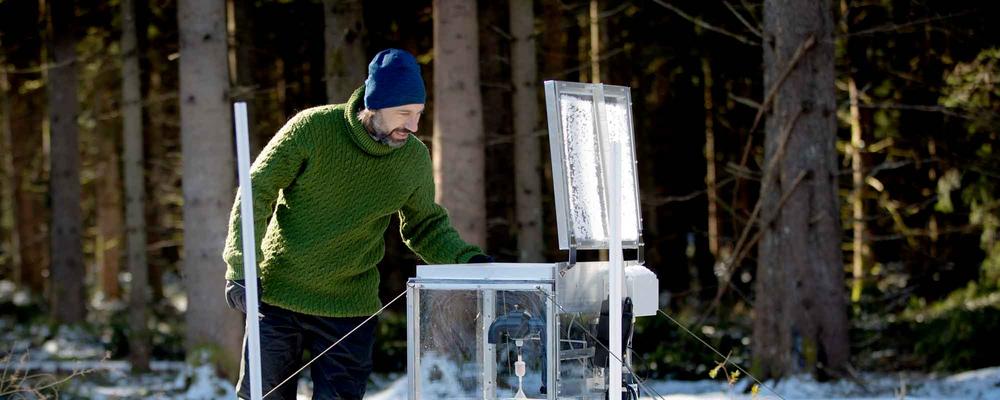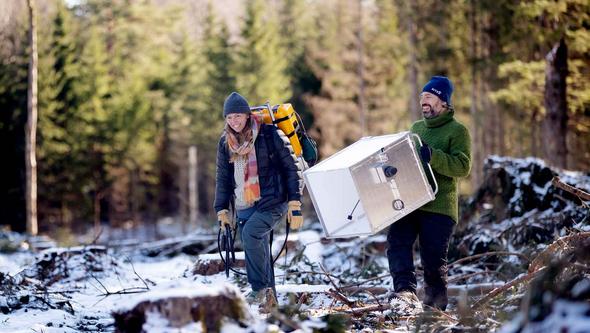
- Home
- Research
- Find research
- He investigates alternatives to clear-felling
He investigates alternatives to clear-felling
As global warming accelerates, the great capacity of Sweden’s forests to capture carbon dioxide has come into the spotlight. At the University of Gothenburg’s Skogaryd Research Catchment, Tobias Rütting is investigating whether changing forestry practices can make this carbon sink more effective over time.
IT’S A SPARKLING cold day in March with sunshine from a blue sky at Skogaryd Research Catchment near Vänersborg. The land at Skogaryd was planted with spruce by the former owners about 60 years ago. Researcher Tobias Rütting walks around and inspects metre-high boxes in a clear-felled area created during the winter. Carbon dioxide emissions are being measured here at ground level. In addition to the clear-felled area, there are similar measuring boxes in two neighbouring areas, one where the spruce trees have been left untouched, and another where an alternative felling method, economic selection cutting, is being tested. Approximately 15 per cent of the trees were felled in the latter area during the winter.
“I’m looking at whether we can find better alternatives to traditional even-aged timber management that is both economically viable and avoid the negative climate effects that arise from clear-felling,” says Tobias Rütting.
WHEN FORESTS ARE CLEAR-FELLED with this system of management, carbon dioxide absorption stops abruptly and the clear-felled area becomes a net emitter of greenhouse gases as the soil continues to release carbon dioxide. Research shows that it can take a few decades for the replanted forest to compensate for the emissions from the soil and to become a carbon sink again.
“Typically, forest owners thin out the planted forest at regular intervals during the growth years to allow the trees to grow optimally before the forest is clear-felled at a given age of the stand, regardless of the trees being different sizes. In economic selection cutting, trees that have reached a certain diameter are gradually felled and the rest are left for another 20 years before the next economic selection cutting takes place. Each tree is assessed individually rather than seeing the stand as a unit.”
THE HYPOTHESIS IS that the remaining trees get a boost and that their growth increases when about 20 per cent of the volume is felled. So there may be an economic benefit to not harvesting the entire stand of trees at once. New trees are expected to start growing spontaneously as the space in the forest increases after economic selection cutting. In addition, the forest owner avoids the costs of soil preparation and replanting that arise after clear-felling.
“We measure the carbon dioxide emitted by the soil and also have tall masts that record the carbon exchange in the air above the tree tops in the forest after economic selection cutting. We want to see whether a forest that has been subject to economic selection cutting can match the carbon dioxide absorption of a conventionally managed forest over an extended period of time,” Tobias explains.
TO MEASURE GROWTH, some of the trees have a silver-coloured mantle on the trunk that measures water movement up to the needles where photosynthesis takes place. The researchers also collect samples that measure how much the trees grow. This allows researchers to calculate the trees’ photosynthesis, which in turn becomes a measure of primary forestry production.
“The good thing about Skogaryd is that there are different habitats in the area: bogs, lakes, watercourses and ordinary woodland. We measure carbon transport in the whole system at six different sites.”
SKOGARYD IS NEAR VÄNERSBORG and tells a fairly typical story of the transformation of Swedish agriculture. Old maps show that the Skogaryd estate utilised the forest as it grew naturally, while other land was cleared for grain cultivation and animal husbandry. In the 19th century, the population grew and the demand for agricultural land increased.
Industrialisation drove up demand for timber and this meant that a lot of land was drained so that production could be increased. This was also the case at Skogaryd, which has a krondike (a wide ditch that was originally financed by the crown/state) running across the estate. After the Second World War, forests were planted in the fields. The livestock were sold and grain cultivation ceased as food production was consolidated into ever larger farms.
“Forestry became a very good source of income, but this also meant that many habitats were sacrificed and biodiversity was drastically reduced. Drainage led to increased carbon emissions from drained peatlands. The problems associated with carbon emissions has come into the spotlight now that we know how important it is to reduce emissions to avoid the consequences of global warming,” says Tobias.

TOBIAS RÜTTING’S RESEARCH requires patience. The definitive answer may be 60 years away.
“I will be a hundred years old then,” laughs Tobias. “This is why we need more experiments in different locations and also to learn from existing experiments.”
In Västergötland, about 85 per cent of cultivated forest is owned privately. Getting them to invest in a different management method to reduce the climate impact of their forests is not easy.
“It’s difficult to find people with knowledge and practical experience of economic selection cutting in Sweden,” says Tobias.
CULTURAL GEOGRAPHER MARIE STENSEKE has just started a project researching the views of forest owners themselves on forestry that reduces climate impact and promotes biodiversity.
“Making the forest industry more efficient has led to large-scale felling, and everything is set up for this. Which can make it difficult for those forest owners who want to do things differently,” says Marie.
Forest owners can be divided into two types of actor governed by different logics. The large companies have no personal relationship with the land they own, while many small- and medium-sized forest owners can have other interests in their holdings.
“It’s easier to argue successfully for biodiversity, sustainability and climate benefit with forest owners who have a personal relationship with their forest. To bring about change in the forestry industry, it is important to find commonalities among these forest owners, and make it easier for them to change their methods by


BY CERTYFING TIMBER that comes from a sustainably managed forest for instance, the market could reward a different forestry method with higher prices to the producer. But this requires regulation, which can be difficult to get through the legislative process.
“Our research focuses on how to make future forestry more sustainable, taking into account local circumstances and local ideas. It may seem like a good thing that the EU issues directives, but apart from Finland and Sweden, there is not much productive forestry in the Member States, where forests are mostly associated with nature conservation. So knowledge about forestry in the EU is at a low level,” says Marie.
Text: Olof Lönnehed
Photo: Malin Arnesson
The debate about forestry
Swedish forestry is the subject of intense debate. Major economic interests and an increased need for timber are at loggerheads with the other benefits provided by forests. The Sami people are critical of the disappearance of reindeer pastures, ecologists provide us with evidence of the loss of biodiversity, and clear-felled areas upset tourists and local residents. The climate benefits of current forestation are also being called into question. Researchers disagree on how to make best use of the fact that growing forests are very good at capturing carbon dioxide.
Skogaryd Research Catchment
Located just outside Vänersborg and run by the Department of Earth Sciences at the University of Gothenburg. The station consists of different ecosystems: marshes, old and young forests, lakes and watercourses. It conducts research using data from flow measurements from soil, watercourses and lakes, combined with chemical analyses. In addition to Tobias Rütting’s research into the climate impact of different types of forestry, there is also an experiment involving rewetting drained peatland. The station was established in 2013.
